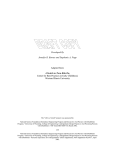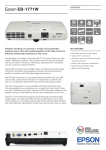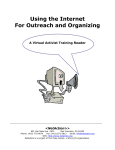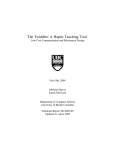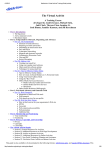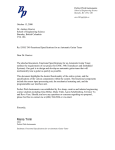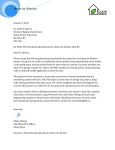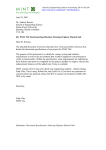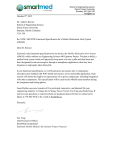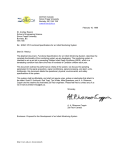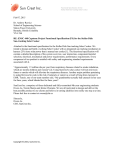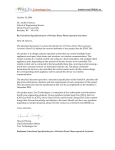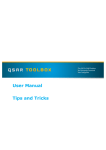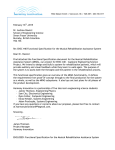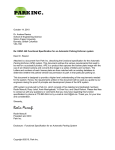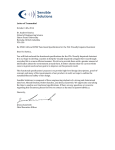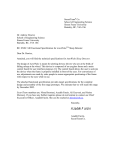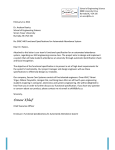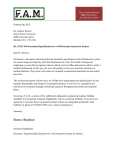Download Haptic Feedback Gaming System Functional
Transcript
Haptic Feedback Gaming System Functional Specification 14/10/2014 Oct 14, 2014 Dr. Andrew Rawicz School of Engineering Science Simon Fraser University Burnaby, British Columbia V5A 1S6 RE: ENSC 440W Functional Specification for 360-NS-HS, a Haptic Feedback Gaming System. Dear Dr. Rawicz, Enclosed in this letter is the function specification for our product, the 360-NS-HS. The purpose of our device is to simulate a realistic weaponry tag experience. The device will utilize RFID technology in combination with a tactical vest and provides feedback in the form of motor vibration and LEDs. The product will also feature two game modes to give users different experiences. The functional specification provides the detail of our product in three parts: RFID input system, gaming CPU control, and the Motor-LED feedback system. We will outline general, physical, electrical, and software requirements. Each section will have a list of desired concepts for the product and it will be used as a reference tool through the development process. RealSimTech is comprised of four striving and inspired engineers: Kamyar Javanmardi, Nielven Jay Olis, Anthony Nguyen, and James Fong. Should you have any questions or concerns, feel free to contact us at 778-881-5751 or by email at [email protected]. Sincerely, Kamyar Javanmardi Chief Executive Officer RealSimTech Enclosure: Function Specification for 360-NS-HS, a Haptic Feedback Gaming System Haptic Feedback Gaming System Functional Specification Project Team: Submitted to: Kamyar Javanmardi Dr. Andrew Rawicz – ENSC 440 James Fong Prof. Steve Whitmore – ENSC 305 Anthony Nguyen School of Engineering Science Nielven Jay Olis Simon Fraser University Primary Contact: Kamyar Javanmardi ([email protected], 778-881-5751) Issue Date: October 14, 2014 Revision 1 Haptic Feedback Gaming System Functional Specification 14/10/2014 EXECUTIVE SUMMARY As time passes, gamers look for more exciting games to play. Although paintball and laser tag are currently the most popular shooting games available, people are always looking for a different, maybe more improved, games to play. Currently these games can be expensive to operate and play, and as these games obtain more popularity, more regulations are applied to control them. The Haptic Feedback Gaming System (HFGS) can solve many issues that are related to these types of timeless activities. The system will be a familiar, but new experience for people who enjoy alternative sports. The proposed solution by RealSimTech addresses inadequacies related to paintball and laser tag by presenting an improved gaming experience. HFGS will offer better feedback by implementing a Radio Frequency Identification (RFID) to deliver a more lifelike gaming experience to the players and this new way of gaming has other unique features when compared to others. For instance the system consists of a vest that holds multiple vibrating units to provide rumbling effect when hit signal is received from the microcontroller. This document covers the functional specifications for the design and implementation of the Haptic Feedback Gaming System. The tags are placed in projectiles and when they come to close proximity of the RFID reader, a hit signal will be generated and sent to the CPU module. The CPU module will then process and relay the signal to the feedback system. What follows is a breakdown of the project functional specifications and it covers the requirements for the design. The information will also be accompanied by a test plan and how it will affect the design modifications in the future. After completion of the prototype, the following functionalities will be operational: o RFID system: the reader module will read the tags from the projectile. o CPU module: the program will read data from the reader, analyzes the input, and sends signal to the feedback system. o Feedback System: it utilizes a power management circuitry and it will drive the motors and turn on the LED’s. o Enclosure: all electronic components will be placed in an enclosure that is fitted in a vest. RealSimTech plans to integrate, test, and provide a working prototype before the end of December of 2014. ii © 2014 RealSimTech Haptic Feedback Gaming System Functional Specification 14/10/2014 TABLE OF CONTENTS EXECUTIVE SUMMARY ................................................................................................................................................................... ii TABLE OF CONTENTS .................................................................................................................................................................... iii LIST OF FIGURES ................................................................................................................................................................................v LIST OF TABLES ..................................................................................................................................................................................v GLOSSARY OF TERMS .......................................................................................................................................................................v 1. 2. 3. 4. 5. 6. iii INTRODUCTION .................................................................................................................................................................... 1 1.1 Scope ................................................................................................................................................................................ 1 1.2 Intended Audience ...................................................................................................................................................... 1 SYSTEM OVERVIEW ............................................................................................................................................................ 2 2.1 General Requirements ............................................................................................................................................... 3 2.2 Physical Requirements .............................................................................................................................................. 4 2.3 Electrical Requirements............................................................................................................................................ 4 2.4 User Interface ................................................................................................................................................................ 4 2.5 Standards ........................................................................................................................................................................ 4 RFID SYSTEM ......................................................................................................................................................................... 5 3.1 General Requirements ............................................................................................................................................... 5 3.2 RFID Transponder Requirements ......................................................................................................................... 5 3.3 RFID Reader Module Requirements..................................................................................................................... 5 CPU Module ............................................................................................................................................................................ 6 4.1 General Requirements ............................................................................................................................................... 6 4.2 Physical Requirements .............................................................................................................................................. 6 4.3 Electrical Requirements............................................................................................................................................ 6 4.4 Software Requirements ............................................................................................................................................ 6 FEEDBACK SYSTEM ............................................................................................................................................................ 7 5.1 General Requirements ............................................................................................................................................... 7 5.2 Physical Requirements .............................................................................................................................................. 7 5.3 Electrical Requirements............................................................................................................................................ 7 ENCLOSURE............................................................................................................................................................................ 8 © 2014 RealSimTech Haptic Feedback Gaming System Functional Specification 6.1 14/10/2014 Vest.................................................................................................................................................................................... 8 6.1.1 Physical Requirements ......................................................................................................................................... 8 6.1.2 Reliability and Durability Requirements ....................................................................................................... 8 6.2 Casing ............................................................................................................................................................................... 8 6.2.1 Physical Requirements ......................................................................................................................................... 8 6.2.2 Reliability and Durability Requirements ....................................................................................................... 9 7. USER DOCUMENTATION................................................................................................................................................... 9 8. SUSTAINABILITY AND SAFETY ....................................................................................................................................10 9. SYSTEM TEST PLAN ..........................................................................................................................................................12 9.1 Typical Usage ..............................................................................................................................................................12 9.2 Testing ...........................................................................................................................................................................12 9.2.1 Stage 1 .......................................................................................................................................................................13 9.2.2 Stage 2 .......................................................................................................................................................................13 10. CONCLUSION ...................................................................................................................................................................14 References ..........................................................................................................................................................................................15 iv © 2014 RealSimTech Haptic Feedback Gaming System Functional Specification 14/10/2014 LIST OF FIGURES Figure 1: High Level Block Diagram ........................................................................................................................................... 2 Figure 2: Operational Flowchart ................................................................................................................................................. 3 LIST OF TABLES Table 1: Material Breakdown of Various Components .....................................................................................................10 Table 2: Stage 1 Testing Plan ......................................................................................................................................................13 Table 3: Stage 2 Testing Plan ......................................................................................................................................................13 GLOSSARY OF TERMS HFGS Haptic Feedback Gaming System RFID Radio Frequency Identification IR Infrared FPS First Person Shooter 360-NS-HS 360 Nexus-Series Haptic-System CPU Central Processing Unit PCB Printed Circuit Board LED Light Emitting Diode DC Direct Current v © 2014 RealSimTech Haptic Feedback Gaming System Functional Specification 14/10/2014 1. INTRODUCTION The 360° Nexus Series Haptic System, 360-NS-HS, is an alternative gaming product that promotes active physical activities while capturing the engaging gameplay of a First Person Shooter (FPS). The system will be designed for ruggedness to be able to withstand rapid body movement and will provide a thrilling experience both indoors and outdoors. Our objective is to give the user an immersive experience by utilizing rumbling features to simulate a FPS action. 1.1 SCOPE This document describes all the functional requirements for the Haptic Feedback Gaming System. It defines reliability, stability, and safety standards in addition to physical, electrical, and environmental requirements. These specifications will refine the design of the device, assembly of components, testing, and future development. 1.2 INTENDED AUDIENCE This functional specification is intended for use by members of RealSimTech to help designing, building, testing, and overall development of 360-NS-HS. This document will ensure the final product meets the expected design plans and goals. It will also guarantee the required functionality throughout the testing phase. 1.3 CLASSIFICATION Throughout this document, the following convention shall be used to denote functional requirements: [𝑅𝑛 − 𝑝] 𝑛 is the functional requirement number. 𝑝 is the priority of the functional requirement as denoted by one of three values: A B C 1 The requirement applies to the proof-of-concept system only. The requirement applies to both the proof-of-concept system and the final production system. The requirement applies to the final production system only. © 2014 RealSimTech Haptic Feedback Gaming System Functional Specification 14/10/2014 2. SYSTEM OVERVIEW Our system will contain three parts: the input RFID system, the gaming control CPU module, and the feedback system’s motor and LED. The input RFID system will act as the trigger to the overall system by sending a signal to the CPU module when an RFID projectile comes in contact with the reader. The gaming CPU module will have a toggle switch that allows the player to choose game modes. Depending on the game mode chosen, the CPU module will relay the signal from the RFID system to the feedback system appropriately. Once the feedback system receives the signal from the CPU module, it will vibrate the motor and LED flashes. This is conceptualized in Figure 1. FIGURE 1: HIGH LEVEL BLOCK DIAGRAM Our game modes will feature two options: a basic mode and a long game mode. In the basic game mode, when a projectile hits the reader, the motors will vibrate, all the LEDs will flash, and the game ends. The long game mode will feature a health aspect to the game. When a projectile hits the reader, the motors will vibrate, one of the LEDs will turn off, but the game will not automatically end. The game will continue and when another projectile hits the reader, another LED will turn off. Once all the LEDs are off, they will flash to a color signaling the user is eliminated. The diagram in Figure 2 describes the path of operation. 2 © 2014 RealSimTech Haptic Feedback Gaming System Functional Specification 14/10/2014 FIGURE 2: OPERATIONAL FLOWCHART 2.1 GENERAL REQUIREMENTS [R1-B] [R2-C] [R3-C] [R4-C] [R5-B] [R6-B] 3 Transponders will be pre-embedded into a projectile for sale. A general type of ammunition will be provided to be compatible with general projecting-toy-guns. HFGS is designed to be used in any environment other than extreme conditions. The retail price should not exceed $200 CAD. The 360-NS-HS will provide haptic feedback for the wearer. The 360-NS-HS will provide visual feedback to none wearers. © 2014 RealSimTech Haptic Feedback Gaming System Functional Specification 2.2 PHYSICAL REQUIREMENTS [R7-B] [R8-C] [R9-C] [R10-C] [R11-C] 2.3 The 360-NS-HS is to be adjustable for different body shapes and sizes. The 360-NS-HS will come in two default sizes of small and medium US Standard men sizes. The 360-NS-HS will not exceed 4 Kg in weight. The power supply dimensions will not exceed 3 cm x 7cm x 10 cm. The power supply should not exceed 1 Kg in weight. ELECTRICAL REQUIREMENTS [R12-C] [R13-C] [R14-C] [R15-C] [R16-C] [R17-C] 2.4 The power supply will be replaceable and rechargeable. A power adapter will be provided to recharge the battery. The power supply will have enough current to be able to power the CPU module, motors and LEDs. The on/off switch controls the power input to the CPU Module. The power supply should provide at least 4 hours of regular use. The power supply should be recharged from fully drained to fully replenished in less than 2 hours. USER INTERFACE [R18-C] [R19-A] [R20-B] [R21-B] [R22-B] 2.5 The 360-NS-HS will provide a power indication for the power supply. The user will have a game mode toggle. The user will have an on/off switch as well as reset switch. The on/off switch is to power down the CPU module. The reset switch will reset the game mode. STANDARDS [R23-B] [R24-B] [R25-B] 4 14/10/2014 The RFID System conforms to: ISO/IEC 14443, 15693, 18000, 15961, 15962, 15963[5]. The feedback system shall conform to [2]: C22.2 NO. 68-09 - regarding motor-operated appliances intended for use with nominal system voltages of 600 V and less. CAN/CSA-C22.2 NO. 0-10 - General requirements - Canadian electrical code, part II. C22.2 NO. 0.8-12 - Safety functions incorporating electronic technology. C22.2 NO. 100-14 - Motors and generators. All electronics must be lead free to comply with the RoHS Directive. © 2014 RealSimTech Haptic Feedback Gaming System Functional Specification 14/10/2014 3. RFID SYSTEM The purpose of the RFID System is to keep track of valid hits occurring and relay this information to the CPU module. A basic RFID System consists of two components, a RFID transponder and a RFID reader module[5]. 3.1 GENERAL REQUIREMENTS [R26-B] [R27-B] [R28-B] 3.2 RFID TRANSPONDER REQUIREMENTS [R29-B] [R30-B] [R31-B] 3.3 The transponder shall be a passive RFID transponder. The transponder shall be embedded in a projectile. The projectile should provide adequate protection to the transponder upon impact. RFID READER MODULE REQUIREMENTS [R32-B] [R33-B] [R34-B] [R35-B] 5 The reader and the transponder must be compatible with one another. The reader and the transponder must not be exclusive to one another A valid hit requires that the reader module be in contact with the transponder. The reader module shall be read-only. The reader module should be able to read any number of transponders. The reader module should re-read a transponder any number of times. The reader module should not read more than one transponders at once[3]. © 2014 RealSimTech Haptic Feedback Gaming System Functional Specification 14/10/2014 4. CPU Module The CPU module will act as the control center that bridges the RFID and feedback system 4.1 GENERAL REQUIREMENTS [R36-B] [R37-B] [R38-B] [R39-B] [R40-B] 4.2 PHYSICAL REQUIREMENTS [R41-C] [R42-C] 4.3 The CPU module must not exceed 30 grams in weight. The CPU module dimensions must not exceed 7 cm x 6 cm x 1 cm. ELECTRICAL REQUIREMENTS [R43-B] [R44-B] [R45-B] 4.4 The CPU module will receive power through a power jack. The CPU module will receive the rated voltage and current required by manufacturer specification. The CPU module will output signals via digital pins. SOFTWARE REQUIREMENTS [R46-A] [R47-A] [R48-B] [R49-C] [R50-C] 6 The CPU module will receive signals from the reader module. The CPU module will write to the feedback system based on received signal from the reader module. The CPU module must be compatible with the reader module. The CPU module should not write to the reader. The CPU module will be placed in an enclosure to prevent physical damage. The code for the module is written in the C language. The code will provide two modes of operation: a basic game mode and a long game mode. The code will provide an option to reset the game modes via reset switch. The code is written with the least amount of instructions possible so that the CPU module can transfer data efficiently. The software is non-open sourced. © 2014 RealSimTech Haptic Feedback Gaming System Functional Specification 14/10/2014 5. FEEDBACK SYSTEM The motor and LED Feedback system will consist of multiple vibrating motors and programmable LED strips. The vibrating motors will provide haptic feedback for the wearer of the 360-NS-HS and the LEDs will provide visual feedback to none wearers 5.1 GENERAL REQUIREMENTS [R51-B] [R52-C] [R53-C] 5.2 PHYSICAL REQUIREMENTS [R54-B] [R55-B] [R56-B] [R57-B] [R58-B] [R59-C] [R60-C] 5.3 The motors and LED strips must be encapsulated in plastic cases for protection and safety. The motors and LED strips must not move from its original position under normal condition. Placements of the motors and LED strips must not hinder or obstruct the user in maneuvering. The circuit board that contains all electronic components must be enclosed for safety. The circuit board must be easily accessible for troubleshooting and debugging. The Motor and LED Feedback System must not weigh more than 1kg. The feedback system should be modular for quick addition or replacement of components. ELECTRICAL REQUIREMENTS [R61-B] [R62-B] [R63-B] [R64-B] 7 The motors and the LEDs are controlled by the CPU Module. The motors must vibrate for, at most, 3 seconds. The LED strips must be visible enough to be seen from a distance of 100 ft. The motors and LEDs must operate in rated voltage and current required by manufacturer specification. The DC power supply must power both the motors and the LED strips sufficiently under full load. All electrical wires must be insulated. All electrical circuits and components must be isolated from the user’s skin components must be properly grounded. © 2014 RealSimTech Haptic Feedback Gaming System Functional Specification 14/10/2014 6. ENCLOSURE The enclosure keeps all the components together and protects the components from impacts and physical stress. 6.1 VEST The vest consists of compartments to hold reader modules, CPU module, power supply, vibrator motors, LED strips, and wirings. 6.1.1 PHYSICAL REQUIREMENTS [R65-C] [R66-C] [R67-B] [R68-B] The vest should not weigh more than 1 Kg. The vest has adjustable straps to fit different body types and sizes. The vest has the right number of pouches to hold the components. The compartment for the power supply is easily accessible. 6.1.2 RELIABILITY AND DURABILITY REQUIREMENTS [R69-B] [R70-B] [R71-C] 6.2 The vest can hold the weight of all the system electronics. The vest should be stable on the body upon rapid movements. The vest must be ruggedly constructed. CASING The casing consists of boxes to hold the electronic circuits, the CPU module, and the wirings. 6.2.1 PHYSICAL REQUIREMENTS [R72-C] [R73-C] [R74-B] 8 © 2014 RealSimTech The casing should not weigh more than 0.25 Kg. The casing should be 1 cm longer than the dimensions of the enclosed contents. The casing can be opened for repair and maintenance. Haptic Feedback Gaming System Functional Specification 14/10/2014 6.2.2 RELIABILITY AND DURABILITY REQUIREMENTS [R75-C] The casing should withstand the pressure of at least 1 Kg/cm2 without losing its shape. [R76-C] The casing’s holes for the wirings should withstand standard stress pulls. The casing should be able to withstand small amounts of liquid from entering its enclosure. The casing should be able to keep out dust or other foreign particles. The casing should be able to dissipate heat. [R77-C] [R78-C] [R79-C] 7. USER DOCUMENTATION This section describes the user documentation to be provided for the HFGS. [R80-C] [R81-C] [R82-C] [R83-C] [R84-C] [R85-C] [R86-C] 9 A user manual will be provided for the 360-NS-HS. The user manual will include the company information and contact for troubleshooting and general questions. A section of the user manual will describe the proper procedure and the parts needed to operate our product. A section of the user manual will describe improper use and potential safety concerns. The user manual is to be understandable for a general audience of ages greater than 14 and without any knowledge of general mechanics or electronics. The user manual will be written in English and at least one other language relevant to the geographical location HFGS is being marketed in. An information sheet will be included to inform users of proper disposal of the 360-NS-HS. © 2014 RealSimTech Haptic Feedback Gaming System Functional Specification 14/10/2014 8. SUSTAINABILITY AND SAFETY Sustainability is an important factor for our product. It is important that our product produce a minimal impact to the environment as well as maximize cradle-to-cradle design, where the product’s materials can be recycled/melted down so it can be reused in the future or the materials can be returned to nature (if organic) [1]. The table below lists materials that are typically found in various parts and components. A technical nutrient is a material that is man-made and can be reused, while a biological nutrient is a material that can be returned to nature Nutrient Material Parts and components Technical ABS/polystyrene/ polycarbonate Electronic enclosures Technical Nylon, various fabric Vest Technical Steel alloy, aluminum Wires, screws, motors case/weight Neither Fiberglass, copper, epoxy resin, various metal (gold, tin, nickel) PCB, protoboard Neither Silicon, silicon oxide, aluminum, others Integrated Circuits (ICs) Technical Carbon, various metals Resistors/capacitors/inductors/ motors Technical Tin Solder on PCB TABLE 1: MATERIAL BREAKDOWN OF VARIOUS COMPONENTS The vest will be made of a textile material. Therefore, it can either be donated or recycled. The electronic enclosures are typically made of a type of plastic and this material can be downcycled to a different product. Electronic components on PCBs will be the main issue as with most electronic devices in the world, since there are countries that ship obsolete and toxic electronic waste to other countries [4]. Our idea is to include an information sheet in our product that will aid the consumer in properly disposing the product if necessary. 10 © 2014 RealSimTech Haptic Feedback Gaming System Functional Specification 14/10/2014 Safety is critical component in our product. Since it is wearable, the electronics that the vest houses will be in close proximity to the body. We must ensure that all electronics are secured and isolated from the user’s skin to prevent any electrical shock and that no electrical wires are accidently pulled by the user. The enclosures will be padded with a soft material to cover any sharp edges and to prevent injury to the user in the case they fall down and land on their body. The PCB circuitry will be designed to minimize heat so that the user will not feel an increase in temperature due to the circuit heating up the enclosure. In the case the circuitry creates a spark due to an arc, the vest material is chosen so that it cannot melt or catch fire. 11 © 2014 RealSimTech Haptic Feedback Gaming System Functional Specification 14/10/2014 9. SYSTEM TEST PLAN This section will describe the test plan to be followed during the development stages of the HFGS. By first looking at the typical usage of the HFGS in the long game mode, we can outline the appropriate tests needed to be done. The long game mode is chosen as it requires the most programming and enables the most immersion. How the user plays with the HFGS will not be considered. 9.1 TYPICAL USAGE 1. 2. 3. 4. The user will put on the 360-NS-HS The user will power on the 360-NS-HS The user will select the game mode The user will maneuver with the vest on. 4.1. The vest and the components it encloses will be faced with various stresses and impactful force 5. The user will be shot by a projectile 5.1. A user will be shot by a projectile with more than one LED on 5.1.1. The vibrating motor will provide a haptic feedback to whichever body part the user was shot on 5.1.2. One LED will turn off to signal the user was shot 5.2. A user will be shot by a projectile with one LED on 5.2.1. The vibrating motor will provide haptic feedback to all body parts 5.2.2. All of the LEDs will flash to a color signaling the user is eliminated 5.2.3. The CPU module will cease to accept anymore reader module reads 6. The user can reset or power-off the 360-NS-HS 6.1. Choosing Reset 6.1.1. The LED will reset to an initial state 6.1.2. The CPU module will restart accepting reads from the reader module 6.2. Choosing Power-Off 6.2.1. The 360-NS-HS is powered down 7. The user will take off the 360-NS-HS 9.2 TESTING Testing is done in 2 Stages to ensure maximum efficiency in time and resources. Testing will try to adhere to the Typical Usage. 12 © 2014 RealSimTech Haptic Feedback Gaming System Functional Specification 14/10/2014 9.2.1 STAGE 1 Stage 1 testing will be testing of individual systems and their components. Each system can be tested simultaneously. Stage 1 Unit Tested Test Reader module is able to read the RFID tags at projected speeds LEDs and motors adheres to programming requirements Vibrating motors provide adequate haptic feedback RFID System Feedback System Vest is rugged enough to handle user maneuver and wear Enclosures Casings of components can handle relatively strong impactful force Typical Usage Section 5 5.1 5.2 5.1.1 5.2.1 1 4 7 4.1 TABLE 2: STAGE 1 TESTING PLAN 9.2.2 STAGE 2 Stage 2 testing will be testing the integrated system by combining all the systems together. By the end of Stage 2 testing, product should be able to adhere to a typical usage. Stage 2 Unit Tested Test User interface is handled adequately Integrated System The vest is comfortable to wear and maneuver with Feedback is provided in response to the RFID System TABLE 3: STAGE 2 TESTING PLAN 13 © 2014 RealSimTech Typical Usage Section 2 3 6 1 4 7 5 Haptic Feedback Gaming System Functional Specification 14/10/2014 10. CONCLUSION RealSimTech is in the process of designing, developing, and building a haptic feedback gaming system to bring an evolved way of gaming and to promote more physical activity to the alternate sport enthusiasts. In the functional specification document, we outlined the functional requirements, which will transform the model from a proof-of-concept mock-up into a marketable prototype. The product with basic functionalities is expected to be ready by the end of November 2014. The goal of our team is to meet all the product expectations listed in this document and further develop a more advanced model that may well be sellable. 14 © 2014 RealSimTech Haptic Feedback Gaming System Functional Specification 14/10/2014 REFERENCES [1] “The Cradle-to-Cradle Alternative”, McDonough Innovation, 2003. [Online]. http://www.mcdonough.com/speaking-writing/the-cradle-to-cradle-alternative. [Accessed 14 10 2014]. [2] The CSA Group (2014). Available: shop.csa.ca/en/canada/products/electrical/icat/electrical. [Accessed 10 10 2014]. [3] "RFID Card Reader Module," 2 2006. [Online]. Available: http://www.rpelectronics.com/Media/Data/MoreInfo/28140.pdf. [Accessed 21 9 2014]. [4] Terry J. Allen. (2008) China is Our E-Waste Dumping Ground. Retrieved April 3rd, 2014 from http://www.alternet.org/story/72529/china_is_our_e-waste_dumping_ground. [5] "Understanding Radio Frequency IDentification (RFID)," rfidcanada, 2014. [Online]. Available: http://www.rfidcanada.com/technologies/. [Accessed 22 9 2014]. 15 © 2014 RealSimTech





















